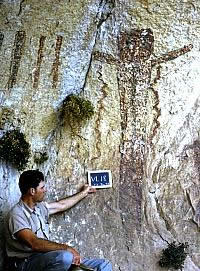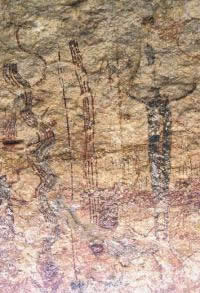Lower Pecos Rock Art
The latter part of the Middle Archaic period (by 2600 B.C.) saw the establishment of a rich “rock art” tradition—painted polychrome images and complex scenes on the walls of rockshelters (natural overhangs) in the canyonlands of the Lower Pecos. Over the next 4,000 years, four distinct styles of rock art evolved in the region—Pecos River, Red Linear, Red Monochrome, and Historic. These styles are thought to have developed in succession. The best known and most abundant is the earliest, the Pecos River style, which dates from about 2700 B.C. (4200 radiocarbon years B.P.) to 1200 B.C. (2950 radiocarbon years B.P.) during the latter part of the Middle Archaic period and the earliest part of the Late Archaic period.
Although many Texans do not know it exists, the rock art of the Lower Pecos is world class—one of the best preserved and most vivid traditions of prehistoric art known anywhere. For years archeologists and others dismissively professed that the meanings of the Pecos River pictographs could never be unraveled except speculatively and vaguely—“hunting magic.” Today with the work of several researchers, especially Dr. Carolyn Boyd of the Shumla School, the Pecos River style is seen as communicating a narrative with carefully composed mural panels reflecting a strong historical and spiritual tradition. Shamanistic religious practitioners are depicted on spiritual journeys sometimes triggered by the sacramental use of medicinal plants. These rituals and the rock art are seen as integral elements of hunter-gatherer life in the region.
To learn more about the art and how anyone can visit some of the best-preserved Lower Pecos rockshelters, vist the following TBH sections and other websites:
Plateaus and Canyonlands exhibit section, Artistic Expression
Lower Pecos exhibit section, Rock Art
Seminole Canyon State Park and Historic Site website
Rock Art Foundation website
Shumla School website

